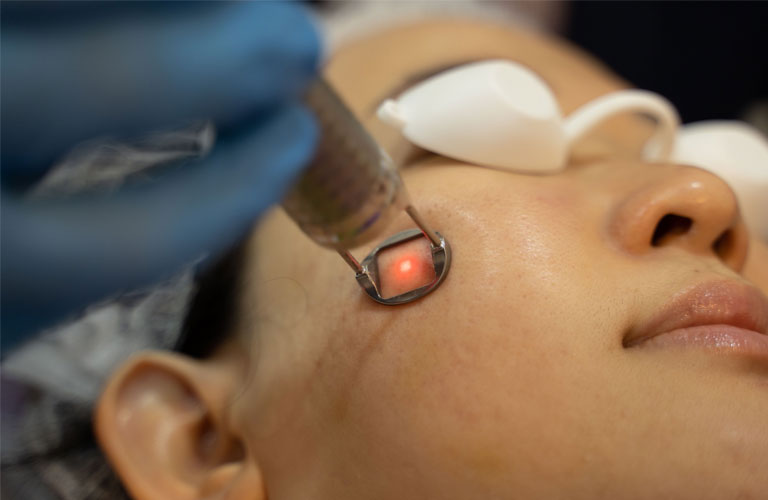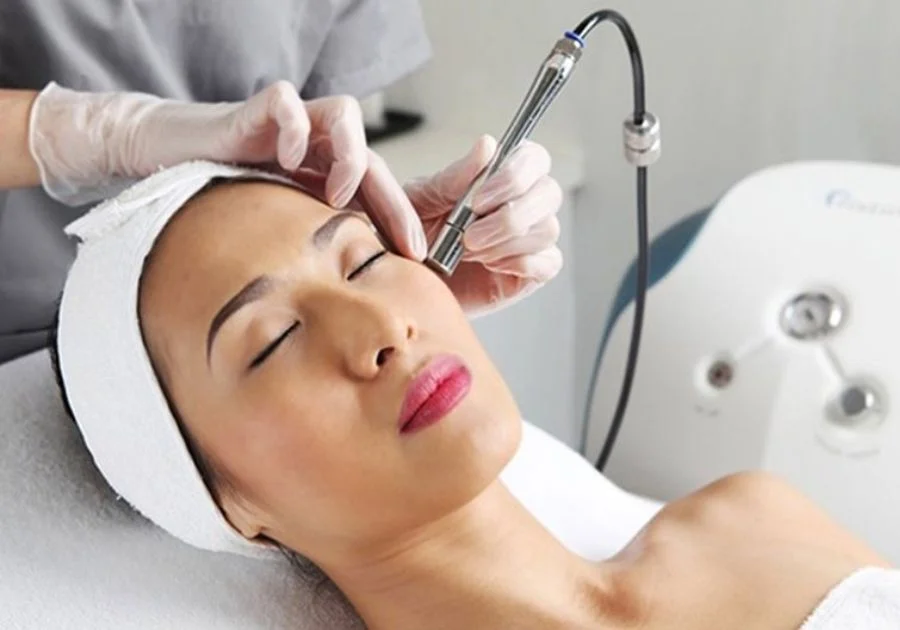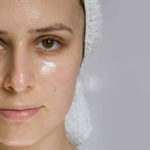Laser uses high-energy light beams to target and break down melanin, resulting in skin discoloration.
Treating deep freckles with laser is a common and effective method, however, deep freckles may reoccur after treatment. Therefore, before treating freckles with laser, it is recommended to consult with a doctor for specific guidance. Additionally, it is advised to use sunscreen when going outside, wear long clothing, and wear sunglasses to protect the skin.
Effective laser treatment protocol for deep freckles
Treating deep freckles with laser is a highly effective and safe method. This method works by targeting and breaking down the pigmented cells on the skin, resulting in a brighter and more even skin tone. Below is a reference protocol for effectively treating deep freckles with laser:

Illustrative image
1. Doctor assesses skin condition
Before undergoing laser treatment for deep freckles, the doctor will examine and assess the skin condition, and then explain the laser freckle treatment methods. This is to ensure the best and safest results.
During the consultation, the doctor may discuss some issues:
- Medical history and medications being used
- Skin health check, type of freckles, severity level
- Identifying goals and expectations of freckle treatment
- Explaining the risks and benefits of laser freckle treatment
- Addressing any concerns
2. Perform laser freckle treatment
After receiving consultation and determining laser freckle treatment, the doctor will provide information about the procedure and proceed with the treatment. The treatment steps include:
Apply numbing cream: Before laser treatment, the dermatologist will apply a numbing cream to the skin to reduce discomfort during the freckle treatment process. The numbing cream is usually applied 30-60 minutes before the treatment begins.
Eye protection: The doctor will provide protective goggles to shield the eyes from laser light. Laser light is very strong and can cause eye damage if not properly protected. In this case, the laser goggles will block the light and keep the eyes safe.
Proceed with the treatment: After the numbing cream takes effect and the eyes are protected, the doctor will proceed with the laser freckle treatment. The laser beams will be directed straight onto the freckled area to remove the freckles, contributing to a brighter, lighter, and more even skin tone. You may feel slight tingling or mild discomfort during the treatment process. Typically, the laser freckle treatment process takes about 30 minutes to complete.
3. Post-treatment care
To enhance the effectiveness of the treatment, the doctor will provide detailed instructions for at-home skin care. It is important to follow the instructions to promote wound healing and minimize the occurrence of complications.
Following the post-laser freckle treatment skin care plan offers several benefits:
- Promoting the wound healing process and limiting complications
- Protecting the skin from sunlight and preventing deep freckles from becoming more severe
- Maintaining and ensuring the effectiveness of laser freckle treatment
Post-laser freckle treatment skin care plan:
- Apply cold compresses to the skin to reduce swelling, redness, and discomfort.
- Use sunscreen, shield the skin carefully, and avoid direct exposure to sunlight. After laser treatment, the skin will be more sensitive to sunlight, making it susceptible to damage and pigmentation. Avoid sun exposure, especially within 2 weeks after laser treatment.
- Use gentle skin care products, avoid strong soaps, facial cleansers, or harsh exfoliants on the skin, for at least 1-2 weeks after laser treatment.
- Moisturize the skin by applying a moisturizing cream multiple times throughout the day. This helps retain moisture and prevent skin peeling. Additionally, drink plenty of water to promote optimal skin health and recovery.
Furthermore, the doctor may also suggest additional supplementary skincare methods, depending on the needs and individual conditions. Important aspects after laser freckle treatment include patience and proper skin care. It may take a few weeks or more to see the results of the treatment.
How many sessions are required for laser freckle treatment?
The number of laser freckle treatment sessions required depends on the skin type, severity of freckles, and the laser used. However, most people will need at least 3-4 sessions, with each session spaced 4-6 weeks apart, to achieve the best results.
Occasionally, some individuals may require additional maintenance treatments to sustain the effectiveness of the freckle treatment. Therefore, it is recommended to discuss individual needs and expectations with a dermatologist to determine the necessary number of laser freckle treatment sessions.

Illustrative image
Risks of laser freckle treatment
- Redness and swelling: Laser beams can cause skin redness and swelling. This condition is usually mild and will improve without treatment.
- Skin peeling: Sometimes laser beams can cause skin peeling. Typically, the skin will peel off a thin layer, causing no pain and can heal on its own without treatment.
- Increased pigmentation: Increased pigmentation is when the skin becomes darker than normal, and it can occur after laser treatment, especially in individuals with darker skin tones.
- Decreased pigmentation: Decreased pigmentation is when the skin becomes lighter than normal, and it can also occur after laser treatment, although it is less common than increased pigmentation.
- Scarring: Scarring is very rare as a result of laser freckle treatment, however, if the laser is set too high or if the skin is not properly cared for after treatment, it may result in scarring. These scars are typically severe, affecting aesthetics and proving difficult to treat.
- Infection: Infection is a rare but serious side effect of laser treatment. Infection can occur if the skin is not properly cleaned and disinfected before laser treatment.
The risks and side effects of laser freckle treatment may vary depending on the type of laser used and the treated area of the body. It is important to discuss the risks and benefits with a dermatologist to develop the most appropriate skin care plan.
Frequency of Facial Sauna and Mask Usage: Advice for Skincare Regimen
 Skincare Regimen’>
Skincare Regimen’>Are you uncertain if you should wear a face mask after taking a sauna? Dien May Xanh can answer that question for you and provide further advice on how often you should steam your face. Let’s take a look at this important topic together!


































